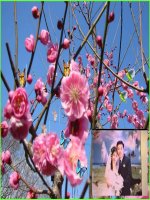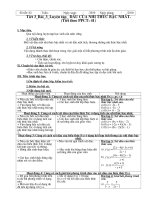Bài giảng New year celebration in VN
Bạn đang xem bản rút gọn của tài liệu. Xem và tải ngay bản đầy đủ của tài liệu tại đây (236.14 KB, 15 trang )
Tết Nguyên Đán
New Year Celebration
in Vietnam
Tết Nguyên Đán
The Vietnamese New Year is called Tết Nguyên Đán,
meaning Feast of the First Morning, or more
commonly by the shorter name Tết.
It is the most popular holiday in Vietnam, and
represents the beginning of the new lunar year.
It also is a break or time of rest in the agricultural
year, since it falls between the harvest of crops and
the sowing of new crops.
Date: February 17, 2007
The holiday originated from China and is based on the
Chinese lunar calendar, so it usually takes place on
the same day as the Chinese New Year. However, it
is different in some years due to the time difference
between Hanoi and Beijing.
2007 is one of those years where it falls on a different
day than the Chinese New Year; in 2007, the
Vietnamese New Year is February 17.
Activities
The new year holiday is a time to:
Honor and remember ancestors
Spend with family
Mark the beginning of a new year
Duration
The holiday consists of 3 periods:
Tất Niên - preparation for Tết
Giao Thừa - eve of Tết
Tân Niên - days of Tết (3 days)
Tất Niên - Preparation
Preparations may begin weeks in advance. In
preparation for the holiday, people often try
to pay off debts to be debt-free for Tết.
Families buy clothes for the children, food,
and decorations for the house and family
altar.
People who live far from home may travel to
get home to celebrate the holiday with family.
Tất Niên - Preparation cont’d
Special foods are prepared, such as bánh dầy
and bánh chưng (below):
Tất Niên – Kitchen Guardians’ Departure
On the 23rd day of the last month of the Chinese
calendar, the three kitchen guardians for the house
return to heaven to report on the events in the house
to the Jade Emperor. For their departure, a family
offers sacrifices for their journey, such as a carp they
can use for their travel, setting the carp free
afterwards. Or the family may put honey on the mouth
of the image of Ông Táo (one of the guardians) so he
can say only sweet things about the family.
Giao Thừa (New Year's Eve)
On the last day of the year, the home is cleaned and
swept. Sweeping or getting rid of trash during Tết is
taboo or xui (unlucky), since it symbolizes sweeping
the luck or good fortune of the new year away, so it
must be done before the holiday and then not until
after the three days of Tết are over.
During the middle of the day, an offering is placed on
the family altar for the family ancestors, and incense
is burned. This is done every day throughout the
festival.
Giao Thừa (New Year's Eve) cont’d
A Mâm Ngũ Quả, or five fruit
tray, is placed on the altar,
symbolizing admiration and
gratitude of the family for the
ancestors and their
aspirations for a life of plenty.
Fireworks were lit (until
outlawed in Vietnam in
1995).
Tân Niên – 3 days of Tết
The first day of the New Year is spent with family. Children
wear new clothes and give elders traditional Tết greetings.
Elders may give children lì xì, a red envelope of money. New
offerings and incense are placed at the family altar.
The second day and third days can be spent visiting other
relatives, in-laws, friends, and local Buddhist temples to pray
or get a fortune reading for the year.
All actions for the three days of the holiday should be pure,
since the holiday may be an omen for the twelve months that
follow. For all three days, people are careful to not to show
anger and not to be rude to people. When the holiday ends,
people will resume their activities in a new spirit.
First Visitor of the New Year
The first person through the door in the new year will reflect the
family's future luck and wealth in the new year. So people never
enter a house on the first day without being invited. The act of
being the first person to enter a house on Tết is called xông đất
or đạp đất. Usually, people with happy demeanor or who had
experienced luck during the previous year is invited first into the
house. In some instances, people with names such as Phúc
(happy), Tài (wealth), Lộc (luck) will be invited to perform this act
of xông đất. However, just to be safe, the owner of the house will
leave the house a few minutes before midnight and come back
just as the clock strikes midnight just to prevent anyone else who
would potentially bring any unfortunate events in the new year
for the household.
Decorations
A New Year tree or cây nêu can be
placed in the courtyard and decorated at
the top with bells, flowers, and red
streamers. This tree will guard the family
from evil spirits while the kitchen
guardians are away. A bamboo pole
often serves as the tree.
The house is decorated with peach
flower branches or a kumquat tree,
symbolizing the fertility and fruitfulness
that the family hopes will come in the
coming year.
Food
Bánh chưng and Bánh dầy are cakes of sticky rice with meat
or mung bean filling wrapped in banana leaves. Bánh chưng
are rectangular and Bánh dầy are circular in shape.
Watermelon is popular since it is considered lucky due to the
red color. Roasted watermelon seeds, hạt dưa, are also
served, and they may be dyed red. Other foods served
include chân giò ninh măng (pig trotters stewed with bamboo
shoot), thịt gà luộc (boiled chicken), and Mứt tết, dried
candied fruits such as coconut.
New Year’s Greetings
Chúc Mừng Năm Mới!
Cung Chúc Tân Xuân!









